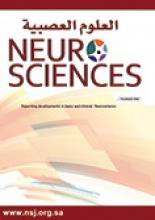Abstract
OBJECTIVE: The aim of the study was to document the neuroimaging findings of children with infantile spasms (IS) seen over a 3-year period.
METHODS: All children below the age of 4 years who presented to the Pediatric Department at the Northern Area Armed Forces Hospital, Hafr Al-Batin, Kingdom of Saudi Arabia from January 1, 1998 to December 31, 2000 with a history of seizures, atypical movements, psychomotor delay, flexor, extensor spasms or both were included in the study. Relevant birth, developmental and family history as well as information on the pattern of fits were documented. Investigations included complete blood count, serum electrolytes, liver function tests, screening for acquired and congenital metabolic disorders. The electroencephalogram, brain magnetic resonance imaging and computerized tomography scans were carried out routinely on all the children.
RESULTS: There were a total of 30 Saudi children, 17 males and 13 females that fulfilled the criteria for evaluation of infantile spasms. The mean age was 10 months. The major causes of IS in this study were congenital brain lesions (40%) infections (20%), and birth trauma/asphyxia (16.7%). The etiology was unknown in 6 (20%) cases. The neuroimaging pattern was dysgenesis (30%), brain atrophy (23.7%), infarctions/hemorrhage (10%) and hydrocephaly (10%). In 8 cases (26.6%) the findings were normal.
CONCLUSION: The neuroimaging findings in this study are comparable with observations in other studies carried out under different clinical settings and environment.
- Copyright: © Neurosciences
Neurosciences is an Open Access journal and articles published are distributed under the terms of the Creative Commons Attribution-NonCommercial License (CC BY-NC). Readers may copy, distribute, and display the work for non-commercial purposes with the proper citation of the original work.






